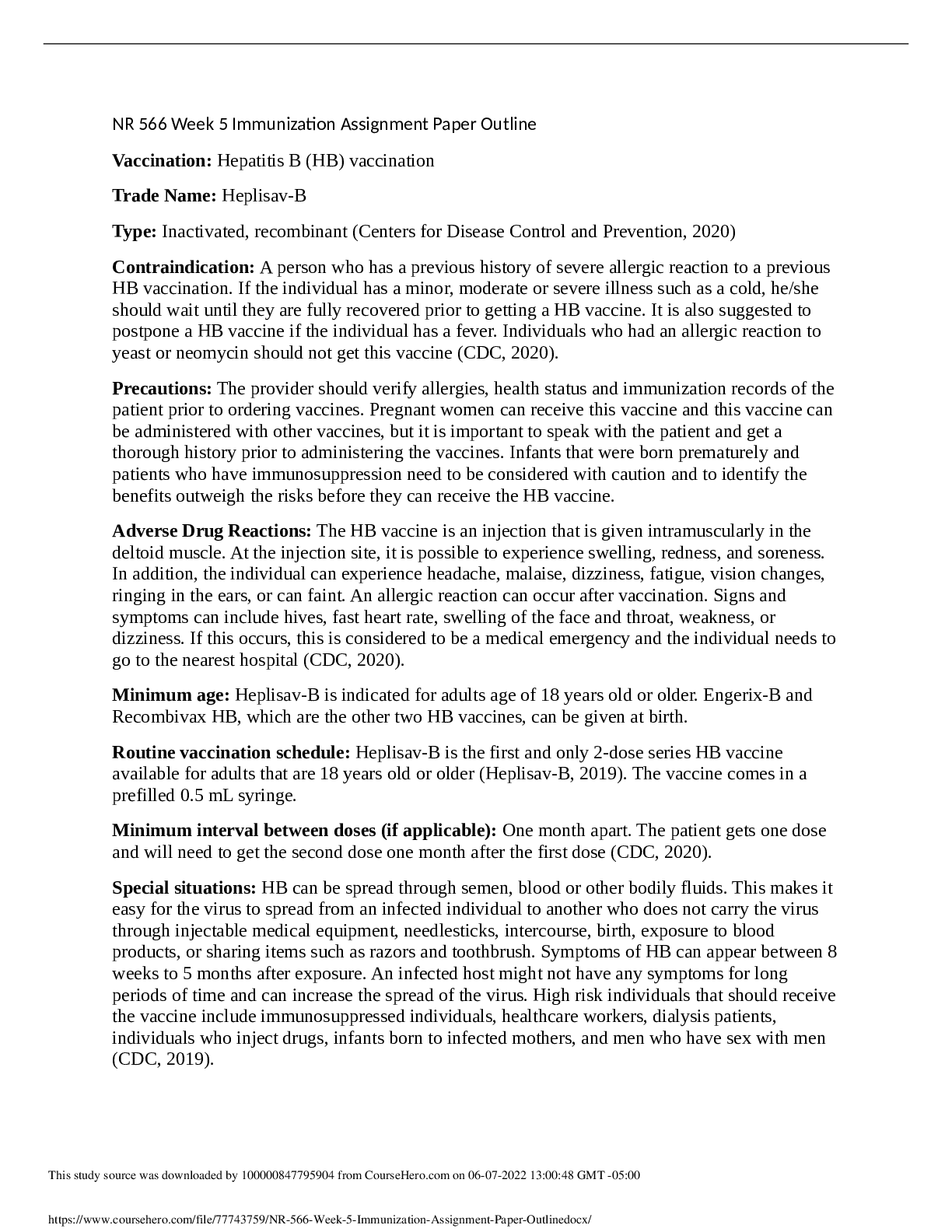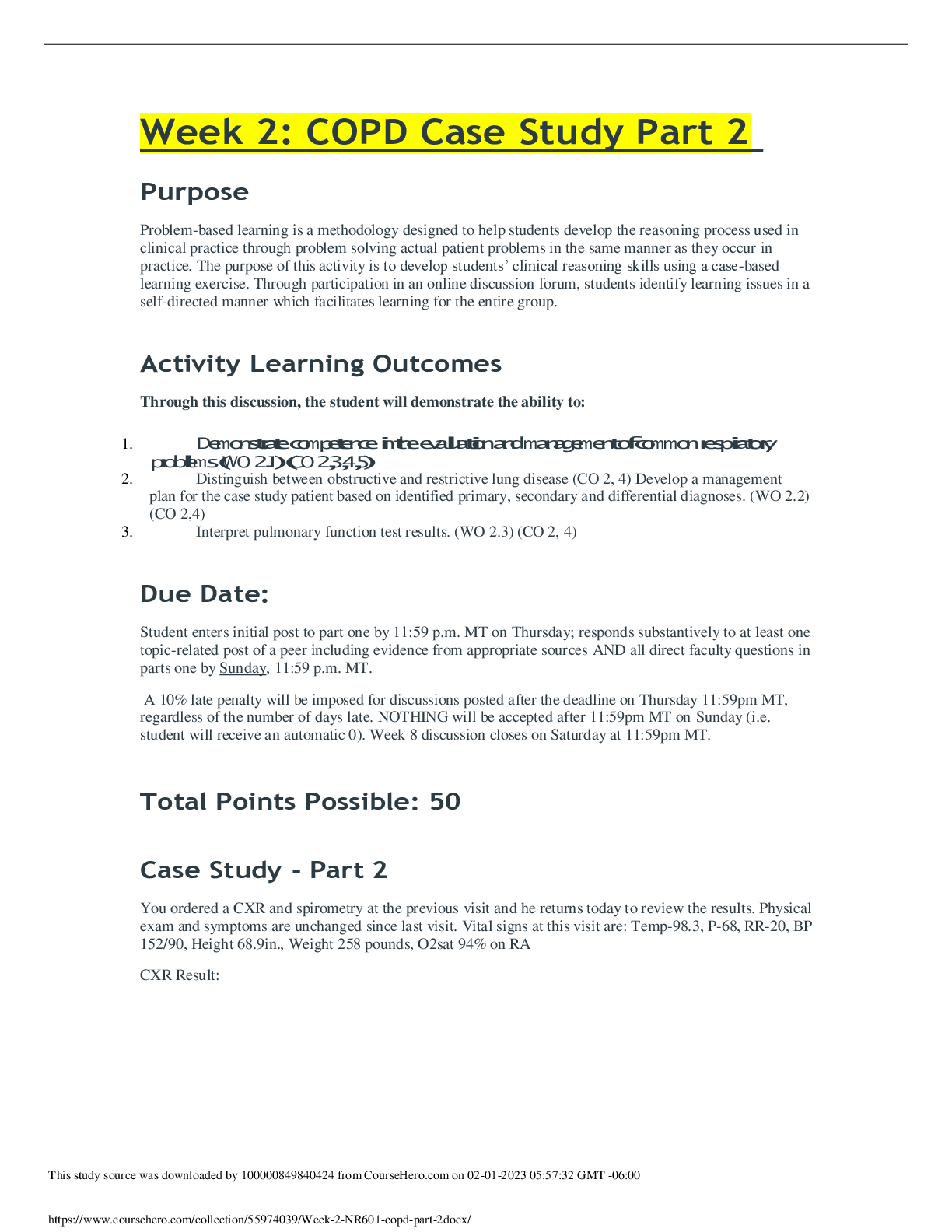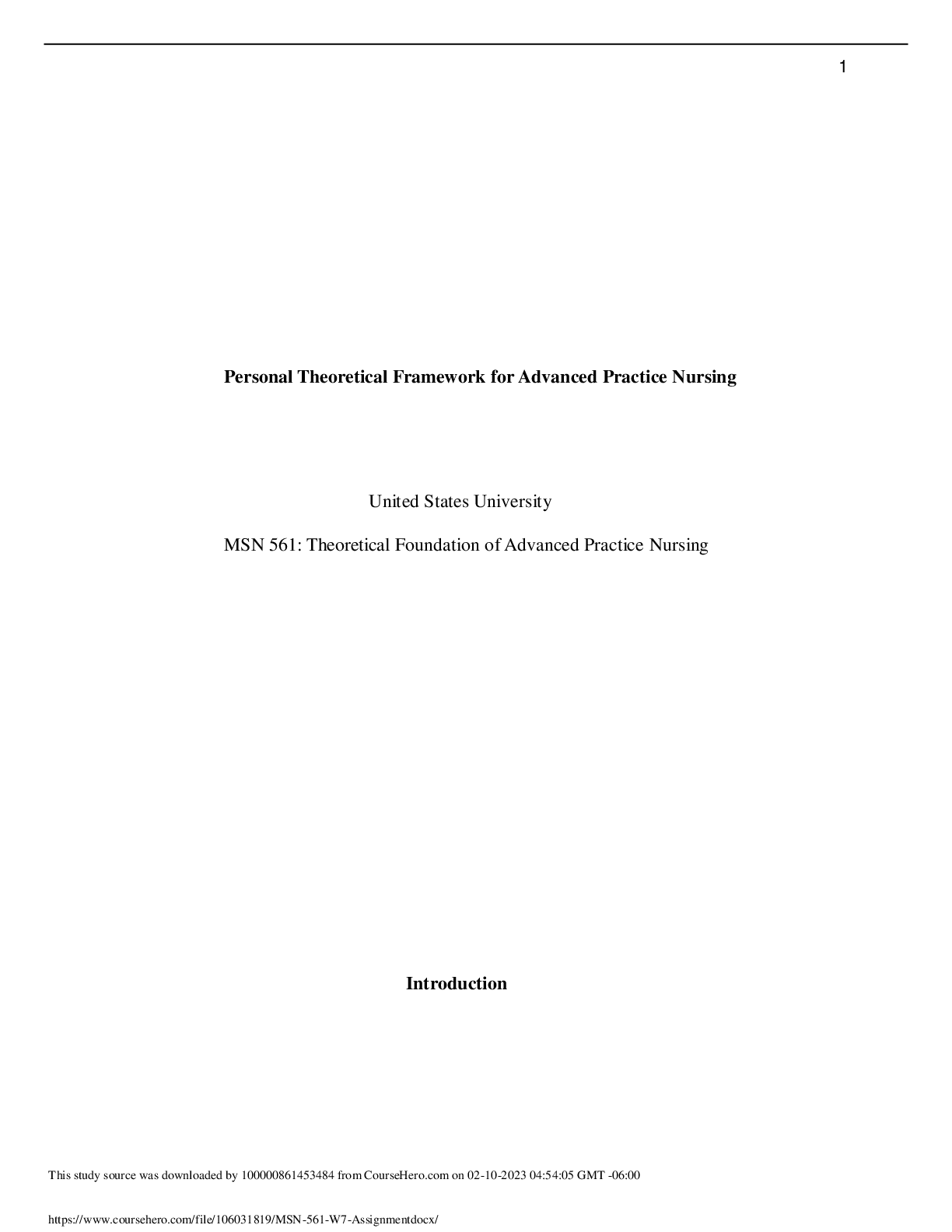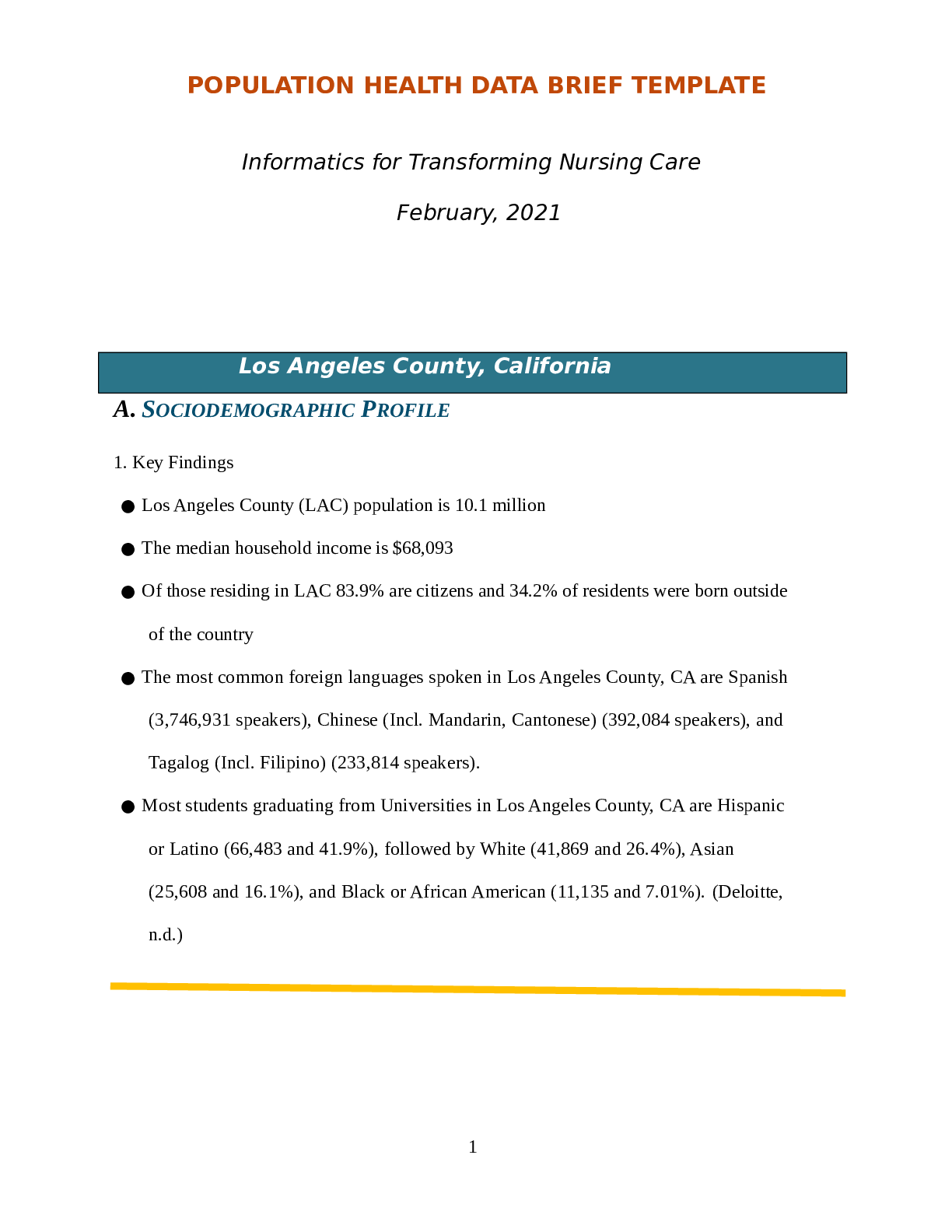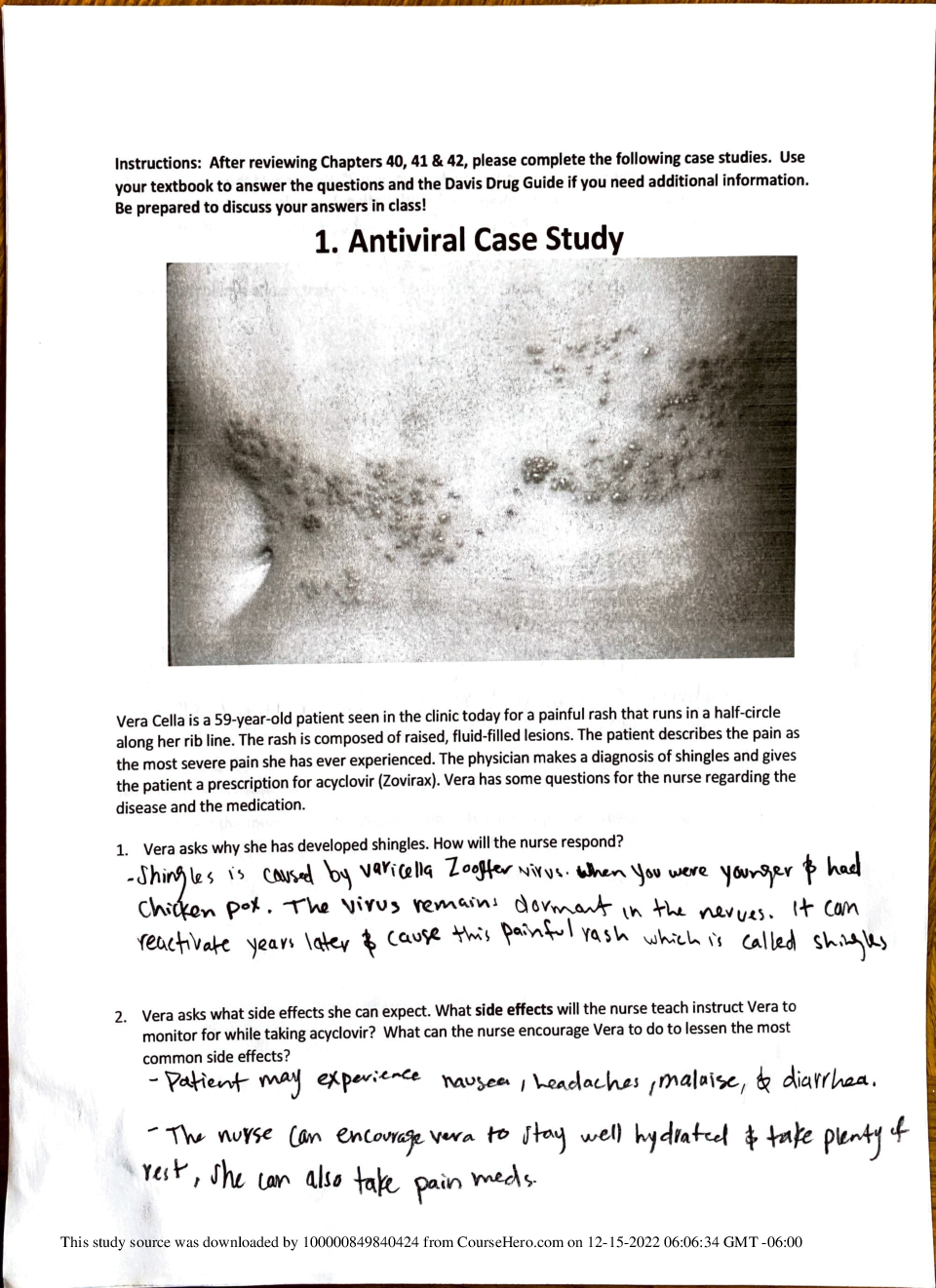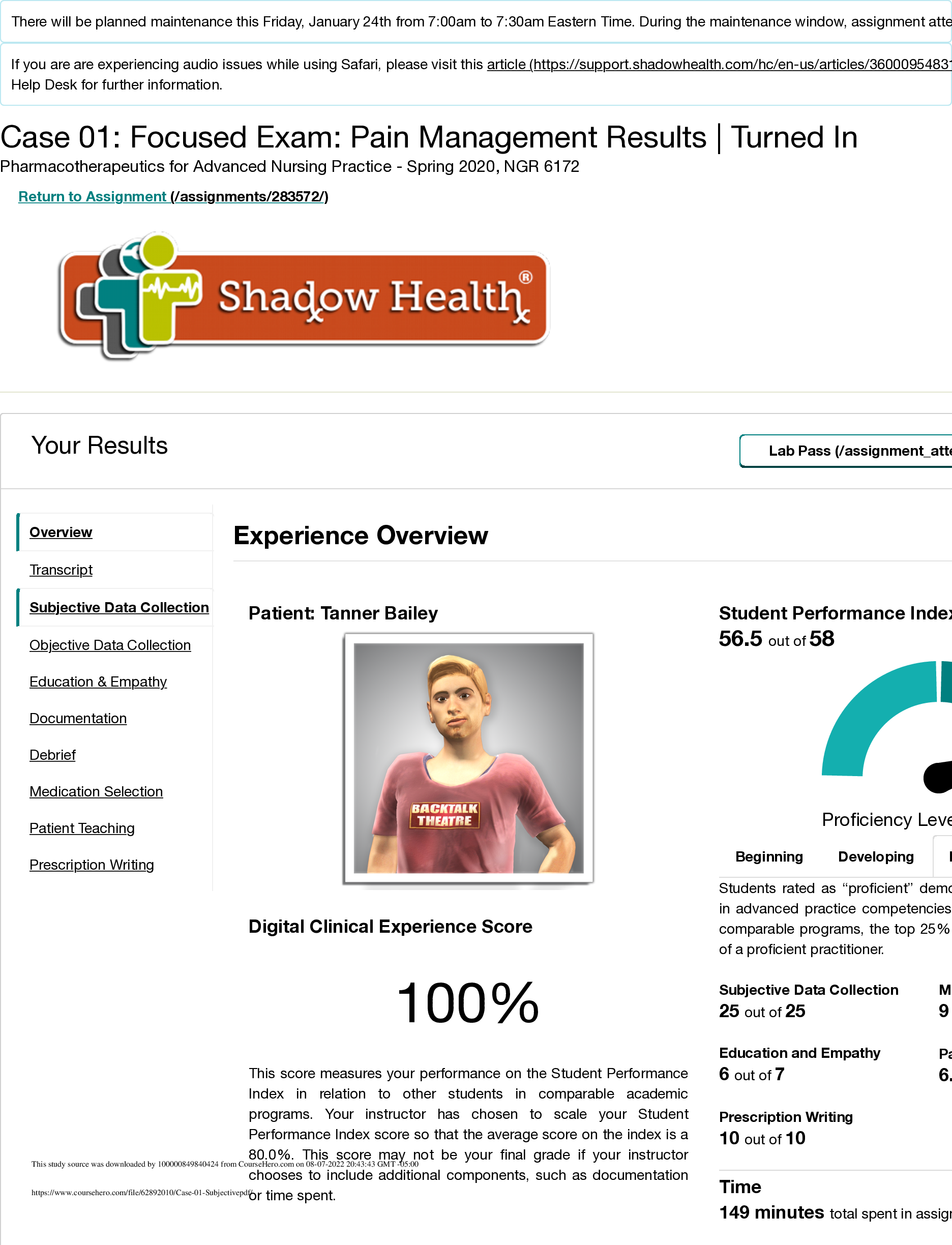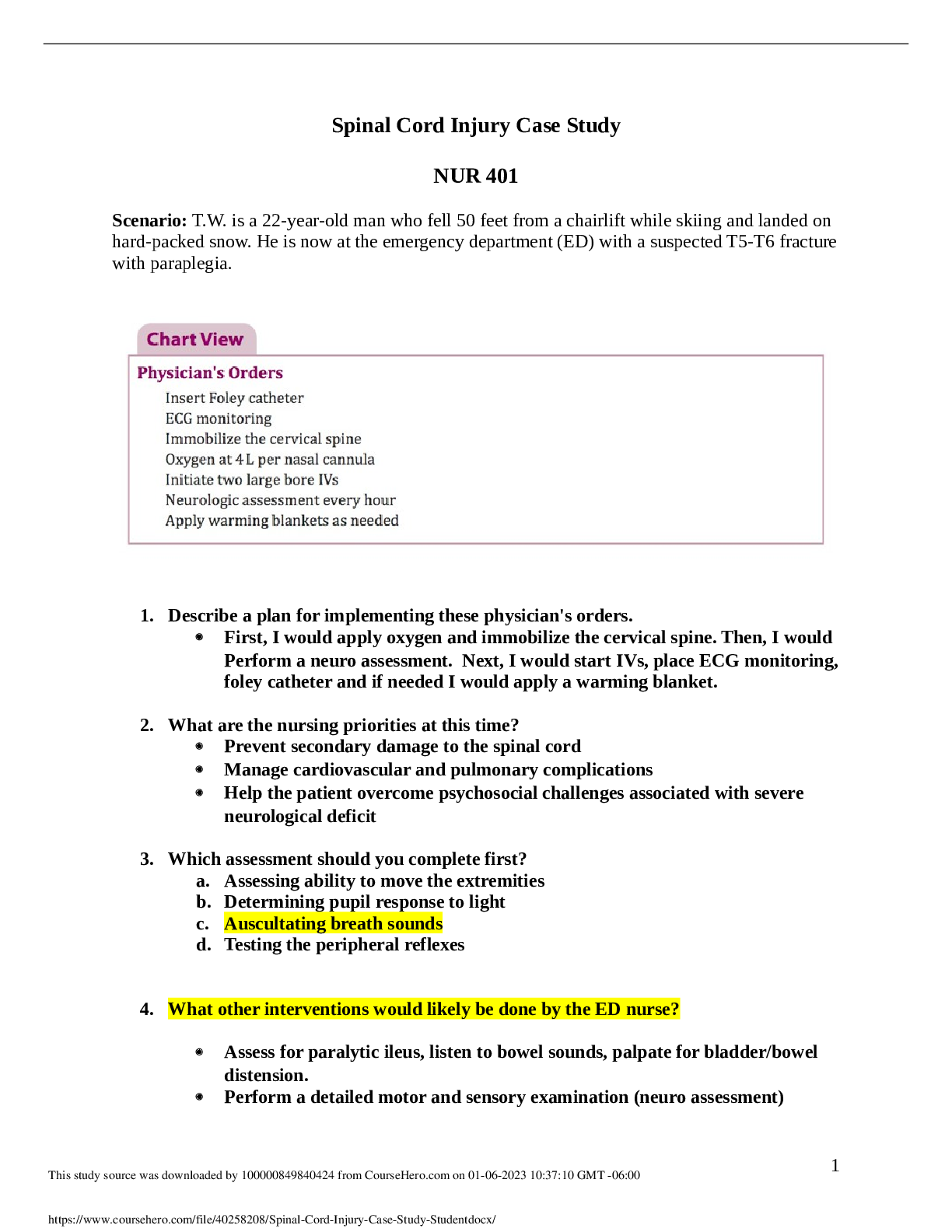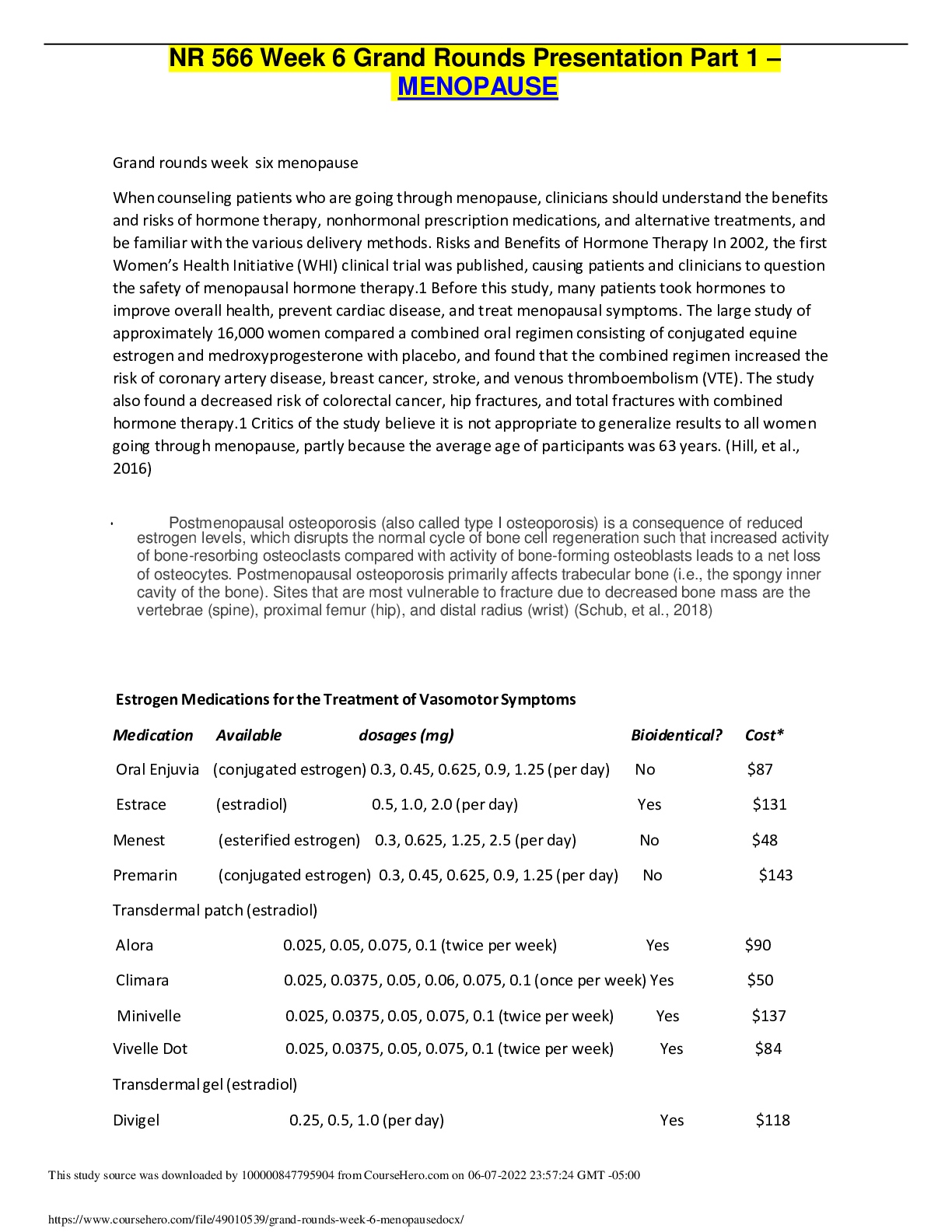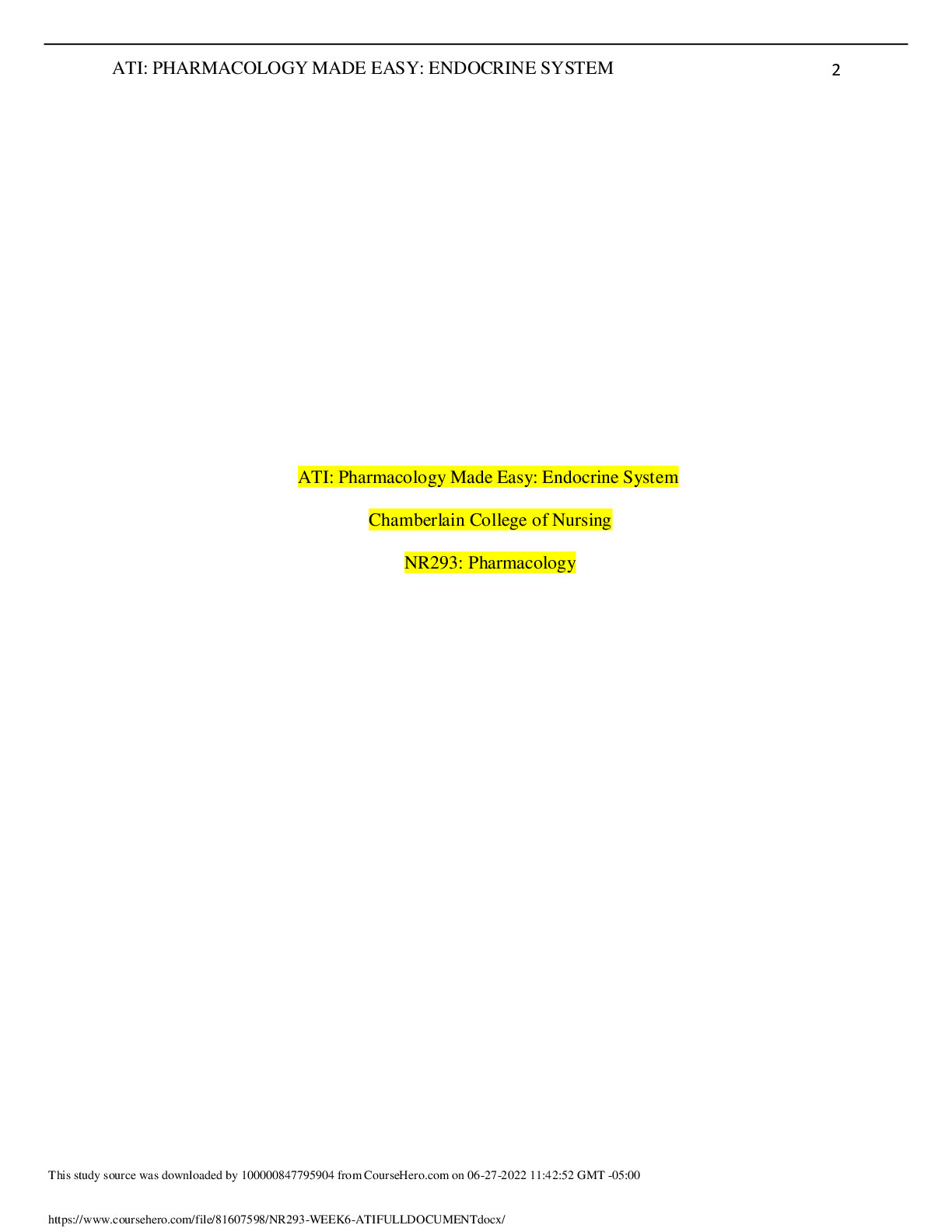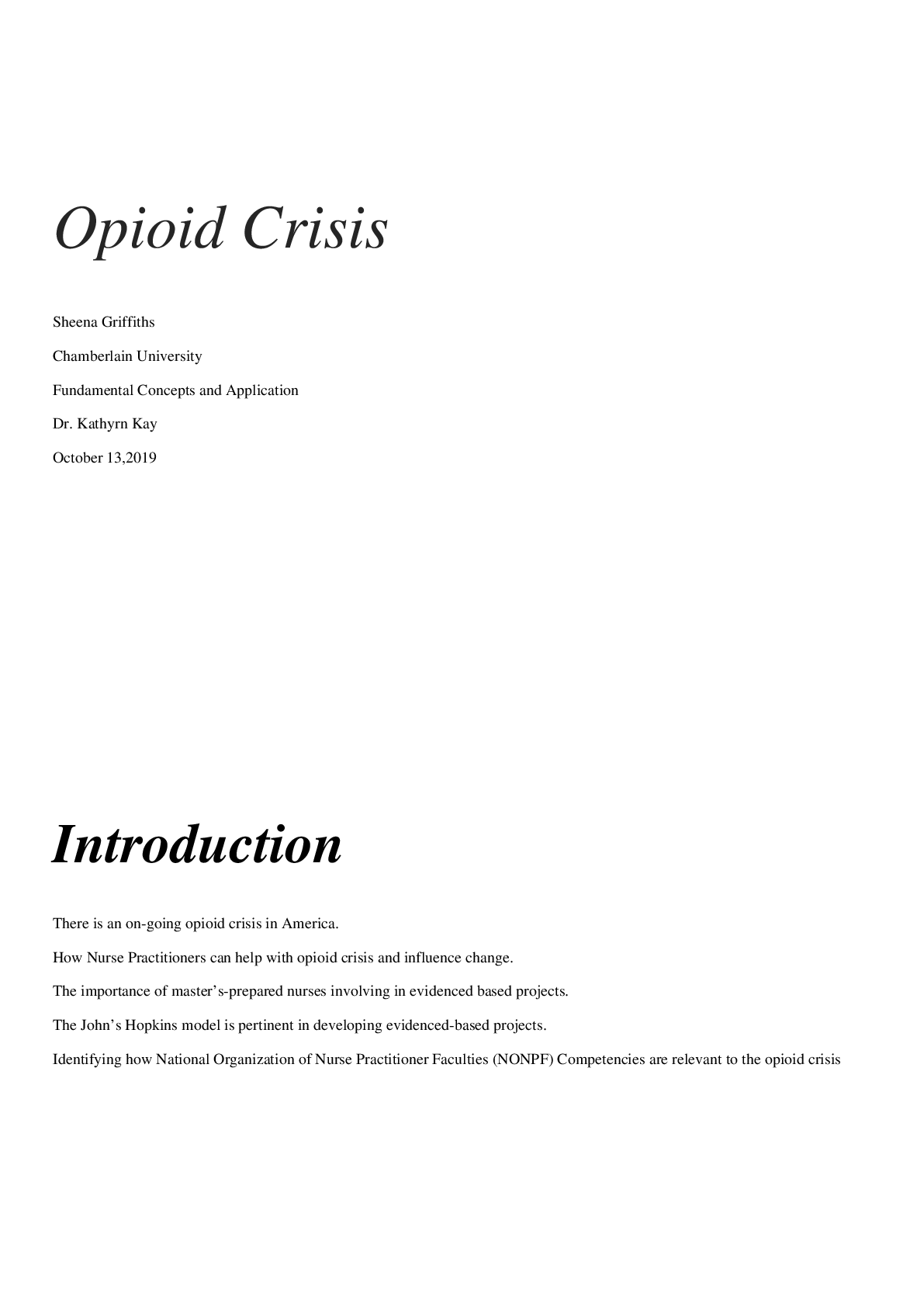*NURSING > CASE STUDY > NR 503 Week 6 Assignment: Epidemiological Analysis: Chronic Health Problem (Epilepsy) | Already GRAD (All)
NR 503 Week 6 Assignment: Epidemiological Analysis: Chronic Health Problem (Epilepsy) | Already GRADED A
Document Content and Description Below
Chronic Health Problem Chamberlain University NR503NP Population Health, Epidemiology, and Statistical Principle Epilepsy is a neurological disorder that impacts the ability of the brain to perfor... m normal activity. This causes seizures and unusual behavior resulting in significant health and mortality disparities. This topic is important, because epilepsy is considered the third most leading brain disorder in older adults after stroke and dementia (Pilgrim & Schub, 2018). People with epilepsy experience recurring and persistent health and socioeconomic disparities, even with expanded rights for persons with disabilities, public awareness programs, education, and access to advance treatment (Koh et al, 2014). According to the CDC, in 2015, the number of people that had active epilepsy was 1.2% of the total US population, which is 3.4 million people with epilepsy nationwide, and of that number 3 million are adults and 470,000 are children (CDC, 2018). According to the latest assessments, about 0.6% of children aged 0-17 years have active epilepsy (CDC, 2018). As a future NP, it is important to learn about this disease and many others in order to provide an effective treatment. In this paper, I will discuss the background and significance of the disease, the current surveillance reporting, and provide a descriptive epidemiology analysis. I will also elaborate on different screening methods used for the disease. Lastly, I will provide information regarding a plan of how the NP will address the chronic health condition after graduation, followed by a conclusion at the end. Background and Significance The Centers for Disease Control and Prevention defines Epilepsy as a disorder of the brain that causes seizures (CDC, 2018). Generally, anyone can be impacted by this terrible disease. In the United States, each year approximately 200,000 new cases of epilepsy are diagnosed, of which 45,000 of that group are children aged < 15 years (Pilgrim & Schub, 2018). Both males and females of all ages, races, and ethnic backgrounds can develop epilepsy, but it’s more common in children and older adults. In order for a person to be diagnosed with epilepsy there must be at least two unprovoked seizure activities (CDC, 2018). Research has linked Epilepsy genetic causes, which makes some people more vulnerable to environmental conditions that can trigger seizures. The risks of developing epilepsy can include head trauma, brain tumor, stroke, infectious disease, development disorder such as autism and central nervous system infection (CDC, 2018). Seizure symptoms can vary greatly depending on the person’s pathophysiological progression involved. A person with epilepsy can have the same type of seizure each time and same symptoms will occur with each episode which can last from a few seconds to a few minutes. Some people may experience staring and blanking spell for a few seconds during the seizure activity, meanwhile others may repeatedly twitch their arms or legs, lose consciousness or awareness, have changes in taste or smell, perform repetitive movements such as walking in a circle, chewing, rubbing hands, collapsing and become unaware of what’s going on around them, or mental symptoms such as anxiety and Déjà vu (CDC, 2018). The seizures can be classified as either focal or generalized depending on the doctors diagnose of the abnormal brain activity present. A focal seizure is the result of abnormal activity from one area of the brain and can occur with or without loss of consciousness, while a generalized seizure, which categories as six different types, impacts all areas of the brain (CDC, 2018). In Georgia, the prevalence of active epilepsy is 110,200, in comparison to the U.S. population of 3.4 million. CDC used national data sources including the 2015 National Health Interview Survey (NHIS) for adults (aged ≥18 years), the 2011–2012 National Survey of Children’s Health (NSCH), and the 2015 Current Population Survey data, describing 2014 income levels, to estimate prevalent cases of active epilepsy, overall and by state, to provide information for state public health planning (CDC, 2015). Table 1 – Prevalence of active epilepsy by age group (CDC, 2018) Age group U.S. population Georgia 0-17 years of age 470,000 16,700 18 and older 3 million 93,500 Surveillance and Reporting Methods Shirley A. Russ, Kandyce Larson, and Neal Halfon did a cross-sectional analysis of data to determine patterns of comorbidity, sociodemographic, and children with reported epilepsy/seizure disorder. The article stated that “from the National Survey of Children’s Health (2007) on 91 605 children ages birth to 17 years, including 977 children reported by their parents to have been diagnosed with epilepsy/seizure disorder in the US, and the result estimated lifetime prevalence of epilepsy/seizure disorder was 10.2/1000 (95% confidence interval [CI]: 8.7–11.8) or 1%, and of current reported epilepsy/seizure disorder was 6.3/1000 (95% CI: 4.9–7.8)” (2012). The study also mentioned that epilepsy/seizure disorder prevalence was higher in lower- income families, and in older, male children. (Russ, Larson, & Halfon, 2012). CDC conducts and supports epilepsy research that helps community health programs by improving surveillance methods to monitor the effect of epilepsy on different populations, and as a result provides the best interventions to improve the life of people with epilepsy. CDC has in place the Managing Epilepsy Well (MEW) Network, which was established in 2007 to conduct research related to epilepsy self-management, along with a group effort of four collaborating center members, and one coordinating center, which is Emory University. A community-based organization called HOBSCOTCH (Home-Based Self-management and Cognitive Training Changes Lives), a self- management program for adults with epilepsy with participants from Georgia, is the current surveillance and reporting data program used for developing, planning and improving community health intervention programs (CDC, 2018). These data are being monitored, because epilepsy can lead to detrimental consequences such as poor quality of life, premature death, and substantial medical costs from hospitalization. The groups from different states work together to monitor and collect data including demographical characteristics, such as income, education level, age, sex, race, ethnicity, and chronic health conditions to provide the appropriate interventions to improve quality of life. Epidemiological Analysis Epilepsy is a chronic non-contagious disease of the brain that has impacted people of all ages. Epilepsy increases the risk for numerous psychosocial challenges which include difficulties with learning, poor social interactions, and poor academic achievement (Miller et al., 2016). According to the CDC, 1.2% of the total US population had active epilepsy, with 150,000 new cases reported each year, and 1 in 26 people will develop epilepsy in their lifetime (CDC,2018) (CDC, 2020). The disease is more common in older people, with more men than women having epilepsy overall. Epilepsy is more common in people of Hispanic background than in non- Hispanics, and active epilepsy is more common in whites than in blacks. According to the World Health Organization (WHO), nearly 50 million people worldwide have epilepsy, making it one of the most common neurological diseases worldwide (2020).The risk factors of epilepsy can include brain damage from trauma during birth, motor vehicle accident, congenital abnormalities or genetic conditions, or an infection of the brain such as meningitis, neurocysticercosi, or encephalitis (WHO,2020). Factors such as lower income status, other health conditions, age, and race have a higher rate of developing epilepsy and seizures (WHO, 2020). Annual health care costs in the United States associated with epilepsy is estimated to be $15.5 billion in direct medical expenses and lost or reduced earnings and productivity (National Institutes of Health, 2018). According to the article by Tian et al., “from 2003 through 2011, the estimated annual suicide mortality rate among people with epilepsy was 16.89/100,000 per persons, 22% higher than that in the general population” (2016). People with epilepsy were more likely to commit suicide by poisoning than those without epilepsy (Tian et al., 2016). Screening and Guidelines To diagnose epilepsy, the doctor first must review signs and symptoms, including medical history. Several tests may be ordered to determine the cause of seizures. The doctor may perform a neurological exam, blood test, or an Electroencephalogram (EEG). EEG is the most common test used to diagnose epilepsy and help determine the type of seizure in patients with epilepsy. This test involves attaching electrodes to the scalp and recording the electrical activity of the brain. If the person has epilepsy, the pattern of the brain waves will be abnormal even without any seizure activity. Although the diagnosis of epilepsy is based mostly on correct patient history, EEG remains a dependable exam with a reasonable sensitivity and specificity as a diagnostic test. Previous studies show that EEG is used to accurately identify adults and children with new- onset epilepsy with a sensitivity and specificity of 17.3% among adults, and 94.7% in children (Bouma et al., 2016). In a study done by Chowdhury et al, regarding how to measure the changes in electro encephalogram (EEG) along with its sensitivity and specificity, the result state that “the overall sensitivity of EEG was 66% (ranged from 62% to 68% with a confidence interval (CI) at 95%) and specificity was 79% (72- 84% at 95% CI). The positive predictive value was 58% (55-61% at 95% CI) and negative predictive value was 41% (38-44% at 95% CI)” (2015). The test reveals that EEG has a reasonable sensitivity and specificity as a diagnostic test for epilepsy. Another test is the computerized tomography (CT) scan. A CT scan uses X-rays to obtain pictures of the brain to detect any abnormalities such as lesions, bleeding or tumors (Pilgrim & Schub, 2018). MRI, PET, and SPECT are all used to diagnose abnormalities in the epileptic brain. These tests use a magnet and radio waves to create a picture of the brain. Plan of Action Epilepsy is a major chronic neurological disorder community health problem among young children and adults. Consistent clinical visits are important for detecting, preventing, and treating this disease. Epilepsy is connected with a series of mental and physical comorbidities that have a detrimental effect on a person’s health. People living with epilepsy faces many tremendous challenges in getting good quality care, and the social stigma attached to epilepsy prevents them from expressing their human rights and experiencing social integration, thus they have fewer educational options, lack of job opportunity due to safety issues while performing their job duties, low self-esteem, inability to drive, and social isolation. As Nurse Practitioners, it is necessary to engage in collaboration with other clinicians to promote health and wellness for patients with epilepsy. It is important for NPs to acknowledge the importance of treating the whole person, meaning holistic, patient-centered care, and addressing the social and psychological aspects of the person’s well-being as well medical concerns, rather than just treating the seizure disorder. In order to help patients understand and manage epilepsy to better improve the quality of life, NPs can implement different evidence-based interventions according to their individual need to improve patient care outcomes. A first primary intervention is providing the patient and family with education programs surrounding awareness of the disease and prevention of triggers. Providing education on the importance of immunization, brain injury prevention, stroke prevention to reduce or eliminate underlying causes and risk factors, use of seatbelt, wearing bicycle helmets correctly when riding bikes, and safeguarding children in car seats to prevent head trauma are all important as well (National Institute of Health, 2018). A secondary intervention is performing early prenatal screening to detect health problems in the developing fetus that may eventually lead to epilepsy and other neurological problems later in life. Screening for cardiovascular disease, high blood pressure, depression, and other disorders that can affect the brain during adulthood and aging that lead to stroke. NPs should also teach self-management care to help patients deal with activities of daily living, as well as teach the importance of being compliant with antiepileptic medication recommendations to improve seizure control, as well as eating well, decreasing stress, and exercising regularly (National Institute of Health, 2018). A third intervention may include rehabilitative therapies, community- based referrals to a neurologist, epilepsy support groups, a psychiatrist for behavioral health support, access to medical care for follow up appointments, and advocacy efforts of reducing the social stigma linked with epilepsy. NPs need to engage and support caregivers in helping with long-term care for their families. The article by Michaelis et al. on treatment interventions states that “evidence supports that psychological therapies that target comorbid mental health symptoms and health‐related quality of life (HRQOL) should be considered in the comprehensive treatment of individuals with epilepsy” (2018). These outcomes can be measured with follow up by primary-care physicians, lab work, evidence of epilepsy mortality rate, and patient experience. The American Epilepsy Society (AES) website is a great resource to provide educational programs for the care of people with seizures and epilepsy. Conclusion Epilepsy is a chronic disease that impacts millions of people in the United States. Nurse Practitioners play a vital role in identifying, treating, and managing epilepsy. It is important for the NP to have a basic knowledge of epidemiological concepts in order to understand the chronic health problem. It is important to be familiar with current surveillance methods and mandated reporting processes, different screening tools, diagnostic tests, and treatment options. This knowledge will allow NPS to provide effective interventions, better care, resources to help with stress management, education for patients and their family members, and enhanced patient outcomes. References Chowdhury, A. H., Chowdhury, R. N., Khan, S. U., Ghose, S. K., Wazib, A., Alam, I., . . . Habib, M. (2015). Sensitivity and Specificity of Electroencephalography (EEG) Among Patients Referred to an Electrophysiology Lab in Bangladesh. Journal of Dhaka Medical College, 23(2), 215-222. doi:10.3329/jdmc.v23i2.25394 Epilepsy Fast Facts. (2018, July 31). Retrieved August 12, 2020, from https://www.cdc.gov/epilepsy/about/fast-facts.htm Epilepsy. (n.d.). Retrieved August 15, 2020, from https://www.who.int/news-room/fact- sheets/detail/epilepsy Koh HK, Kobau R, Whittemore VH, et al. Toward an integrated public health approach for epilepsy in the 21st century. Prev Chronic Dis 2014;11:E146. Michaelis, R., Tang, V., Goldstein, L. H., Reuber, M., Lafrance, W. C., Lundgren, T., . . . Wagner, J. L. (2018). Psychological treatments for adults and children with epilepsy: Evidence- based recommendations by the International League Against Epilepsy Psychology Task Force. Epilepsia, 59(7), 1282-1302. doi:10.1111/epi.14444 Miller, G. F., Coffield, E., Leroy, Z., & Wallin, R. (2016). Prevalence and costs of five chronic conditions in children. The Journal of School Nursing, 32(5), 357–364. https://doi.org/10.1177/1059840516641190 National and State Estimates of the Numbers of Adults and Children with Active Epilepsy - United States, 2015. (2017, August 10). Retrieved August 12, 2020, from https://www.cdc.gov/mmwr/volumes/66/wr/mm6631a1.htm National Institute of Health. National Institute of Neurologic Disorders and Stroke. (2018). Epilepsies and seizures: Hope through research. https://catalog.ninds.nih.gov/ninds/product/Epilepsies-and-Seizures-Hope-Through- Research/18-NS-156 Pilgrim, J., & Schub, T. (2018). Epilepsy: An Overview. CINAHL Nursing Guide. https://chamberlainuniversity.idm.oclc.org/login? url=https://search.ebscohost.com/login.aspx? direct=true&db=nup&AN=T704507&site=eds-live&scope=site Russ, S. A., Larson, K., & Halfon, N. (2012). A National Profile of Childhood Epilepsy and Seizure Disorder. Pediatrics, 129(2), 256-264. doi:10.1542/peds.2010-1371 Tian, N., Cui, W., Zack, M., Kobau, R., Fowler, K. A., & Hesdorffer, D. C. (2016). Suicide among people with epilepsy: A population-based analysis of data from the U.S. National Violent Death Reporting System, 17 states, 2003–2011. Epilepsy & Behavior, 61, 210-217. doi:10.1016/j.yebeh.2016.05.028 [Show More]
Last updated: 7 months ago
Preview 1 out of 11 pages

Reviews( 0 )
Document information
Connected school, study & course
About the document
Uploaded On
Feb 02, 2022
Number of pages
11
Written in
Additional information
This document has been written for:
Uploaded
Feb 02, 2022
Downloads
0
Views
101



